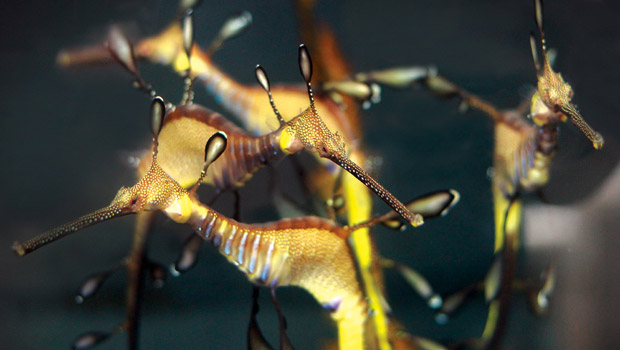Weedy Seadragon

The weedy seadragon (Phyllopterus taeniolatus) is found only in the chilly waters of the Southern Australia and Tasmania, where ocean temperatures seldom rise above 65°F (18°C). Within its definitive habitat of algal beds and rock reefs, the species is found from depths of 10 to 165 feet (3-50 m), where it cruises and hovers as it sucks minute crustaceans from seaweed surfaces and the surrounding water.
What makes this dragon a fish? The weedy seadragon is a relative of the pipefishes and seahorses all are members of the Family Syngnathidae. This group of tube-snouted fishes shares some unique adaptations and look decidedly un-fishlike. For starters, they all have the distinctive tubular jaw that opens rapidly to suck in prey. Then, there are the bony plates that sheath the body in an armor-like casing. Reduced pectoral fins are set just behind the gill cover on the head and are barely detectable. The transparent dorsal fin is set far back on the body and undulates fan-like, providing the propulsion that allows the fish to glide over the seafloor. All other fins are reduced or gone! Perhaps the most unusual syngnathid feature involves the way they reproduce. Sygnathids incubate their eggs on their bodies, holding clutches of eggs between modified fins, embedding them in special skin patches or enclosing them within pouches. And in the seahorses, most pipefishes and seadragons, it’s the males that brood the eggs after receiving them from the females.
Even in a group of fishes known for being unusual, the weedy seadragon pushes the envelope. It is among the largest of the seahorse allies, reaching lengths of nearly 18 inches (46 cm). Its camouflage is intriguing, ribbon-like tabs, called cirri, sprout from its skin and make it hard to recognize as a fish. The scientific name records some of these characters: phyllo means leaf; pteryx is wing; and taeniolatus means broad ribbon. The colors of weedy seadragons vary with age, diet, location and, perhaps, behavior. Those on exhibit at the Waikīkī Aquarium are cream and gray with black edging and patches of fine yellow spots on the head and mid-body. Others range from yellow to reddish-orange with blue stripes on the belly side and patches of yellow-white dots on the upper surface.
There is still much to learn about the weedy seadragon. No one even knows exactly how many exist in its native Australian waters. But, it is certain that this species is rare and the Australian government has taken steps to assure its protection. Collecting is strictly regulated but biologists have been able to raise them in captivity. From this research, scientists have learned that the weedy seadragons may live up to 10 years. When mature, they reproduce one or two times each year, and females may produce up to 300 eggs per clutch. Females transfer the eggs to the male and they are brooded in a special skin patch on his abdomen for two months.
The care and feeding of seadragons is demanding, they require cool conditions and special food. Among aquarium professionals, seadragons are known as challenging to maintain. Waikīkī Aquarium obtained our dragonettes obtained from an Aquaculture program in Australia. The seadragons are fed live mysis shrimp, by hand, 2-4 times per day.
Quick Facts
Scientific name
Phyllopterus taeniolatus
Distribution
southern Australia
Size
to 18 inches (46 cm)
Diet
crustacean plankton
Support the Aquarium
Contact Us
Honolulu, HI 96815
(808) 923-9741
Search
- Already a Volunteer?
- Click Here To Sign In


 Donate
Donate
